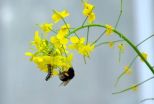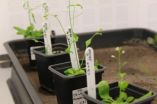(Press-News.org) Tamiflu is one of the few available treatments for those who come down with the flu. But the virus quickly develops resistance; multiplying at a rate of several generations a day, these tiny pathogens rapidly accumulate genetic mutations. Because of this, they have a good chance of developing counterattacks to the antiviral. How can these infinitesimal variations be identified within the immensity of the virus' genetic code? EPFL researchers have created a computer tool that can shed light on the flu virus' formidable adaptability. They were able to find mutations that conferred resistance that had up to this point not yet been identified. Their software has been made freely available to researchers everywhere, and is the subject of an article published in the journal PLOS Genetics.
Widespread use of Tamiflu leads to resistance
In theory, Tamiflu should only be used by patients in fragile health. But during the 2008-2009 flu season, the drug was used for the first time on a very wide scale. Resistant strains of the virus appeared within just a few weeks. Fortunately, even though the mutation induced a resistance to Tamiflu, it also caused a reduction in the replication rate of the virus. Once the use of the antiviral was dialed back to a more reasonable level, the resistant strains lost their competitive advantage, and they disappeared, submerged by competitors that were sensitive to the drug but had a higher rate of replication.
Resistance always results from random mutations, says Jeffrey Jensen, co-author of the EPFL study. But when a mutation leads to a competitive advantage, for example the ability to resist against a source of aggression, it tends to be passed on to its descendants. "A priori, nothing distinguishes one mutation from another; they're all the result of chance. Our goal is precisely to be able to tell the difference between mutations that make the virus resistant to Tamiflu, thus leading to a selection phenomenon, and other mutations."
New resistant mutations are discovered
To begin, the team led by Jensen and his colleague Matthieu Foll cultured ordinary H1N1 virus in the laboratory. Certain groups were subjected to Tamiflu, others not. Every 48 hours – 13 generations – the biologists sequenced the virus' genome to reveal the genetic mutations that had occurred in the interval.
The more the genetic mutations of viruses exposed to Tamiflu tended to become prevalent with time, the higher the probability that they would confer resistance. With a complex statistics-based software tool, the researchers were able to pinpoint 12 sites on the viral genome that carried suspect variations. One of these was already known, but the rest had not yet been identified.
Weeding out the resistance-conferring mutations
Using their statistical software, the researchers were able to comb through the immensity of the viral genetic code and identify only the mutations that were suspected to cause resistance, with a certainty of more than 99% - making their software a powerful tool indeed.
And these newly discovered mutations are reason for concern: they could allow the virus to be resistant while maintaining an elevated reproductive capacity. Jensen thus doesn't exclude the possibility that pathogenic strains could appear that are both competitive and Tamiflu-resistant, if the mistake of 2008-2009 is repeated. For Foll, first author on the study, "the risk is real, and we need to investigate further."
INFORMATION: END
Tamiflu-resistant influenza: Parsing the genome for the culprits
EPFL scientists have developed a tool that reveals the mutations that make influenza resistant to Tamiflu, and they have identified new mutations that may render ineffective one of the few treatments currently available on the market
2014-03-31
ELSE PRESS RELEASES FROM THIS DATE:
Using different scents to attract or repel insects
2014-03-31
Flowering plants attract pollinating insects with scent from their flowers and bright colours. If they have become infested with herbivores like caterpillars, they attract beneficial insects like parasitic wasps with the help of scent signals from their leaves. The wasps then lay their eggs in the caterpillars and kill the parasites. Floral and foliar scents can, however, mutually reduce their attractiveness. That's why flowering plants face a dilemma: should they use their resources to attract pollinating insects and, by extension, for reproduction or should they invest ...
'Cosmic barometer' could reveal violent events in universe's past
2014-03-31
Exploding stars, random impacts involving comets and meteorites, and even near misses between two bodies can create regions of great heat and high pressure.
Researchers from Imperial College London have now developed a method for analysing the pressure experienced by tiny samples of organic material that may have been ejected from dying stars before making a long journey through the cosmos. The researchers have investigated a type of aromatic hydrocarbon called dimethylnaphthalene, which should enable them to identify violent events in the history of the universe.
Samples ...
Hearing loss affects old people's personality
2014-03-31
The researchers studied 400 individuals 80-98 years old over a six-year period. Every two years, the subjects were assessed in terms of physical and mental measures as well as personality aspects such as extraversion, which reflects the inclination to be outgoing, and emotional stability. The results show that even if the emotional stability remained constant over the period, the participants became less outgoing.
Interestingly, the researchers were not able to connect the observed changes to physical and cognitive impairments or to age-related difficulties finding social ...
Mild hypothermia for treatment of diffuse axonal injury: A quantitative DTI analysis
2014-03-31
Mild hypothermia has been shown to exert apparent neuroprotective effects in animal models of diffuse axonal injury. However, the clinical efficacy of mild hypothermia is controversial. Thus, a noninvasive, accurate, and objective technique is urgently required to verify the effect of mild hypothermia in diffuse axonal injury and its prognosis. Fractional anisotropy values in diffusion tensor imaging (DTI) can quantitatively reflect the consistency of nerve fibers after brain damage, where higher values generally indicate less damage to nerve fibers. Therefore, Guojie Jing ...
Emotional children's testimonies are judged as more credible
2014-03-31
In an experimental legal psychology study, two young actors (one girl and one boy) portrayed victims in a mock-police investigation. They were questioned by the police about how they had been harassed by older schoolmates. The police interviews were videotaped in two versions: In one version the children appeared in a neutral manner but in the other version, the children showed clear signs of distress, as they sobbed and hesitated before answering the police officers' questions.
The films were later shown and assessed by law students that were familiar with the Supreme ...
Nano-paper filter removes viruses
2014-03-31
Nanotechnology and Functional Materials, Uppsala University have developed a paper filter, which can remove virus particles with the efficiency matching that of the best industrial virus filters. The paper filter consists of 100 percent high purity cellulose nanofibers, directly derived from nature.
The research was carried out in collaboration with virologists from the Swedish University of Agricultural Sciences/Swedish National Veterinary Institute and is published in the Advanced Healthcare Materials journal.
Virus particles are very peculiar objects- tiny (about ...
CAMH researcher discovers 2 new genes linked to intellectual disability
2014-03-31
(Toronto) March 31, 2014 – Researchers at the Centre for Addiction and Mental Health have discovered two new genes linked to intellectual disability, according to two research studies published concurrently this month in the journals Human Genetics and Human Molecular Genetics.
"Both studies give clues to the different pathways involved in normal neurodevelopment," says CAMH Senior Scientist Dr. John Vincent, who heads the MiND (Molecular Neuropsychiatry and Development) Laboratory in the Campbell Family Mental Health Research Institute at CAMH. "We are building up a ...
NTS's role in the protection of pre-moxibustion on gastric mucosal lesions
2014-03-31
Moxibustion may have protective effects on the stomach mucous membrane against stress gastric ulcer. The potential mechanism of moxibustion may be mediated by transforming growth factor-α, gastric mucosa cell proliferation, inhibition of apoptosis, and the expression of heat shock protein-70. Previous studies have shown that somatic sensation by acupuncture and visceral nociceptive stimulation can converge in the nucleus tractus solitarii (NTS) where neurons integrate signals impacting on the function of organs. To explore the role of the NTS in the protective mechanism ...
New study finds biochar stimulates more plant growth but less plant defense
2014-03-31
In the first study of its kind, research undertaken at the University of Southampton has cast significant doubt over the use of biochar to alleviate climate change.
Biochar is produced when wood is combusted at high temperatures to make bio-oil and has been proposed as a method of geoengineering. When buried in the soil, this carbon rich substance could potentially lock-up carbon and reduced greenhouse gas emissions. The global potential of biochar is considered to be large, with up to 12 percent of emissions reduced by biochar soil application.
Many previous reports ...
Major breakthrough in stem cell manufacturing technology
2014-03-31
Scientists at The University of Nottingham have developed a new substance which could simplify the manufacture of cell therapy in the pioneering world of regenerative medicine.
Cell therapy is an exciting and rapidly developing area of medicine in which stem cells have the potential to repair human tissue and maintain organ function in chronic disease and age-related illnesses. But a major problem with translating current successful research into actual products and treatments is how to mass-produce such a complex living material.
There are two distinct phases in the ...
LAST 30 PRESS RELEASES:
Interaction of climate change and human activity and its impact on plant diversity in Qinghai-Tibet plateau
From addressing uncertainty to national strategy: an interpretation of Professor Lim Siong Guan’s views
Clinical trials on AI language model use in digestive healthcare
Scientists improve robotic visual–inertial trajectory localization accuracy using cross-modal interaction and selection techniques
Correlation between cancer cachexia and immune-related adverse events in HCC
Human adipose tissue: a new source for functional organoids
Metro lines double as freight highways during off-peak hours, Beijing study shows
Biomedical functions and applications of nanomaterials in tumor diagnosis and treatment: perspectives from ophthalmic oncology
3D imaging unveils how passivation improves perovskite solar cell performance
Enriching framework Al sites in 8-membered rings of Cu-SSZ-39 zeolite to enhance low-temperature ammonia selective catalytic reduction performance
AI-powered RNA drug development: a new frontier in therapeutics
Decoupling the HOR enhancement on PtRu: Dynamically matching interfacial water to reaction coordinates
Sulfur isn’t poisonous when it synergistically acts with phosphine in olefins hydroformylation
URI researchers uncover molecular mechanisms behind speciation in corals
Chitin based carbon aerogel offers a cleaner way to store thermal energy
Tracing hidden sources of nitrate pollution in rapidly changing rural urban landscapes
Viruses on plastic pollution may quietly accelerate the spread of antibiotic resistance
Three UH Rainbow Babies & Children’s faculty elected to prestigious American Pediatric Society
Tunnel resilience models unveiled to aid post-earthquake recovery
Satellite communication systems: the future of 5G/6G connectivity
Space computing power networks: a new frontier for satellite technologies
Experiments advance potential of protein that makes hydrogen sulfide as a therapeutic target for Alzheimer’s disease
Examining private equity’s role in fertility care
Current Molecular Pharmacology achieves a landmark: real-time CiteScore advances to 7.2
Skeletal muscle epigenetic clocks developed using postmortem tissue from an Asian population
Estimating unemployment rates with social media data
Climate policies can backfire by eroding “green” values, study finds
Too much screen time too soon? A*STAR study links infant screen exposure to brain changes and teen anxiety
Global psychiatry mourns Professor Dan Stein, visionary who transformed mental health science across Africa and beyond
KIST develops eco-friendly palladium recovery technology to safeguard resource security
[Press-News.org] Tamiflu-resistant influenza: Parsing the genome for the culpritsEPFL scientists have developed a tool that reveals the mutations that make influenza resistant to Tamiflu, and they have identified new mutations that may render ineffective one of the few treatments currently available on the market





